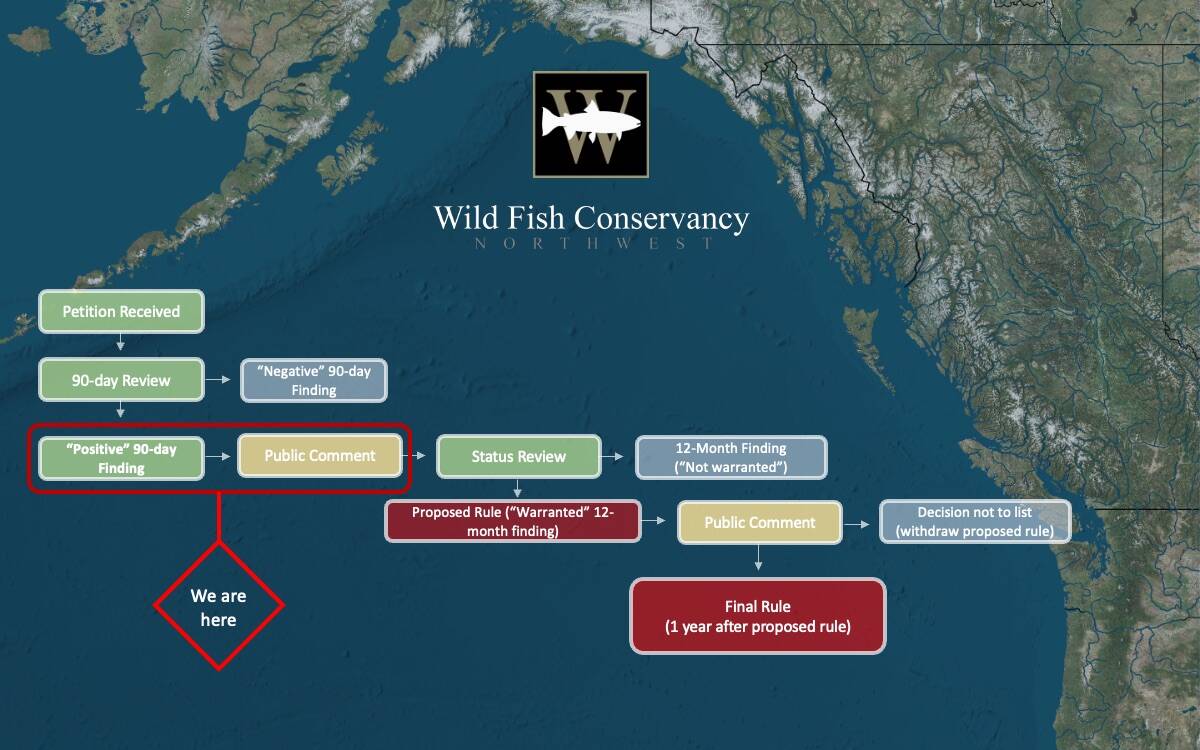Submitted by Wild Fish Conservancy
NOAA Fisheries announced a somber, yet significant milestone in the effort to protect dwindling Alaskan Chinook, also known as ‘king’ salmon. After reviewing a formal petition to list Alaskan Chinook populations as ‘threatened’ or ‘endangered’, the federal agency has made the first ever positive finding for Alaskan-born salmon under the Endangered Species Act (ESA). This determination by NOAA formally accepts the petition, confirming it contains substantial information indicating federal protections for Alaskan Chinook may be warranted and triggering an in-depth scientific review.
Despite their historical abundance and the public perception that Alaskan salmon populations are abundant, data from the State of Alaska shows majority of Chinook populations throughout the state have experienced a significant decline in abundance, size, diversity, and spatial structure, and many have chronically failed to maintain minimum population goals. Recent declines have been so severe that both tribal and non-tribal subsistence Chinook fisheries have been closed in many parts of Alaska. The crisis facing Alaskan Chinook is not unique and mirrors the alarming decline of Chinook in rivers from California through British Columbia.
Wild Fish Conservancy submitted the formal petition to NOAA Fisheries in January of 2024, calling for federal protection for Chinook that return to streams flowing into the Gulf of Alaska and their habitats. The petition initiated a formal 90-day review that resulted in today’s decision.
Emma Helverson, Executive Director of the Wild Fish Conservancy, expressed optimism about the positive finding, stating, “Wild Chinook are a public trust and an irreplaceable public heritage in Alaska and beyond. We are encouraged NOAA Fisheries has acknowledged the severe condition and threats facing Gulf of Alaska Chinook, which underscore the urgent need for comprehensive conservation measures to safeguard the future of these iconic fish on which so many communities and ecosystems depend.”
Alaskan Chinook undertake an extraordinary migration from the rivers they are born in, to marine nursery environments, and back to their home river before spawning, exposing them to persistent threats throughout their lifecycle. To ensure their long-term survival and recovery, conservation efforts are urgently needed to address these threats, which include overfishing, bycatch in trawl fisheries, hatchery impacts, habitat degradation, and climate change.
“Since submitting our petition, we have been contacted by Alaskans throughout the state who support this proactive approach and are alarmed by the disappearance of Chinook in their lifetime. These individuals stressed they are willing to make whatever sacrifices are necessary to ensure future generations can experience these iconic fish,” says Helverson. “In contrast, the seafood industry and certifiers, such as Marine Stewardship Council, continue to lead concerned consumers to believe Chinook from Alaska are sustainable. As the Alaskans we spoke to made clear, no one wants to be eating the last wild Chinook from any river.”
NOAA Fisheries’ decision will continue a one-year review, due to be completed in early 2025. The ‘12-month Finding’ could result in listing Alaskan Chinook as ‘threatened’ or ‘endangered’ and designating critical habitat protections. To ensure the federal agencies have the best available scientific and commercial information, a 60-day public comment period has been initiated and will be open through July 23. Wild Fish Conservancy encourages the public to participate in this important review process.
Nick Gayeski, Senior Ecologist with Wild Fish Conservancy and petition author said, “This is an encouraging first step in what we hope will be a listing of Southeast Alaska Chinook under the Endangered Species Act. Listing should provide the many at-risk chinook populations in this region stronger protection from harms in the near-term and initiate the development of scientifically credible recovery plans.”
Beyond advancing federal protections, Wild Fish Conservancy advocates for expanding marine protection along the migratory corridor and the nursery-rearing environment salmon need in the ocean, habitat restoration and protection efforts that allow fish to adapt to a changing climate, and a transition away from mixed-stock ocean fisheries to selective fisheries in or near rivers where salmon return. This transition is needed to protect at-risk salmon populations and ensure enough fish return to their spawning grounds.
About Wild Fish Conservancy:
Founded in 1989, Wild Fish Conservancy is a nonprofit conservation organization working from California to Alaska to preserve, protect, and restore the Pacific Northwest’s wild fish and their ecosystems, through science, education, and advocacy. To learn more visit wildfishconservancy.org.



